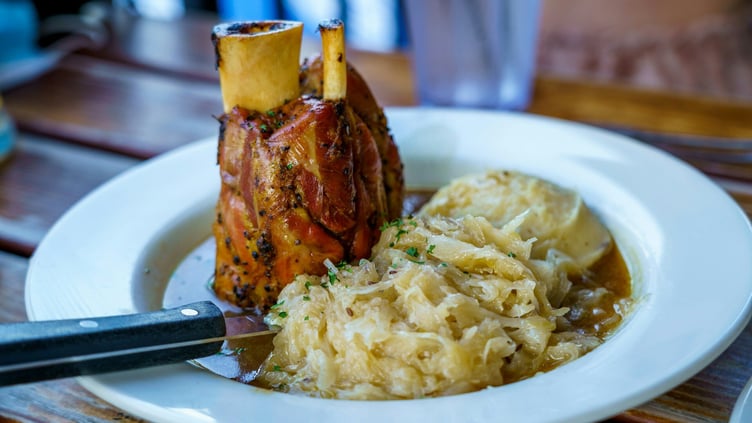
Spaghetti, quiche and other traditional dishes from countries such as Italy and France could now be ripe for reinvention, with modern takes on European fare shaping up to be one of this year’s key cuisine trends, according to Datassential.1
Offering updated versions of classic Italian and other foods can allow operators to please consumers who’d like menu options with some sense of familiarity—while also obliging the 83% who want to see new foods at fine dining, casual sit-down, fast-casual and other restaurants.1
Eating, Italian-Style
Southern Italian cuisine—featuring elements like red sauce and meatballs—was primarily served in restaurants in the U.S. until the 1980s and 1990s, when wine-based sauces, risotto and other components from northern region dishes became more of a focus, according to National Geographic.
Today, a whopping 95% of consumers are familiar with Italian fare1—and operators are again working to introduce diners to some of its lesser-known, yet equally delectable aspects. Stracchino, for instance—a soft, fresh cheese made with whole cow’s milk—has appeared 32% more often on Italian restaurant menus in the past four years.
In addition to off-the-beaten-path pasta shapes like radiatore, pork can potentially play a key role in the Italian entrees restaurants serve. Pork shank’s menu penetration is projected to increase by 28% on Italian restaurant menus over the next 12 months, with bone-in proteins expected to grow 9%.2
Pork can be utilized in numerous ways in Italian dishes—ranging from a highly portable Grilled Sausage Tuscan Sandwich, made with sweet Italian sausage links, red pepper and other savory ingredients, to the Pork Osso Bucco entree family-style restaurant chain Maggiano’s has served over sauteed spinach and garlic mashed potatoes.
Clemens Food Group Corporate Executive Chef Jenny Moyer Murphy suggests incorporating pork into what might otherwise be prepared as chicken or veal Parmesan.
“I like to highlight our Premium Reserve Ribeye or our pork flat iron steak in a Pork Parmesan,” Murphy says. “You can do the traditional preparation, where you pound out the protein and do a breading procedure to create this beautiful dish that takes up the whole plate—because people eat with their eyes.”
Gallic Gastronomy
Like Italian cuisine, the French cooking style has also attained mainstream recognition; more than three-quarters of consumers reportedly are familiar with dishes from the country, according to Datassential’s trends report—which notes enterprising chefs are now “leveraging French cuisine as a vehicle for safe experimentation.” That can, in some instances, include offering items from other countries, such as Senegal, whose cuisine features French influences.
Modern French restaurants often opt for a more casual setting than their predecessors—which may help draw to Gen Z and Gen X members.1 Research from TouchBistro indicates they favor fast-casual eateries that offer a convenient way to socialize.3
French menu items at fast-casual and other restaurants could include this modernized take on the classic “jambon beurre” containing thinly sliced ham, goat cheese, spinach and pepper jam tucked between a baguette.
The Rise of Global Mashups
In addition to serving new versions of classic dishes from specific countries, some restaurateurs have introduced inventive new concepts that pair a European country’s cuisine with another nation’s.
New York’s Koloman restaurant, for instance, helmed by Austrian-born chef and partner Markus Glocker, blends contemporary French and Viennese fare. Its menu includes items like a Berkshire pork schnitzel with lingonberries (tart berries that are popular in Scandinavia).
Montclair, New Jersey’s PastaRamen, which describes itself as “a perfect marriage of Japanese and Italian culture and cuisine,” serves a pork chop scallopini dish and tonkotsu porchetta, with a pork parmigiano broth, fennel and yuzu. Chicago’s Argot adds American touches to French fare in festive dishes like its pigs en croute, essentially pigs in a blanket made with puff pastry and Toulouse sausage sourced from a local meat market, according to Resy.
With a menu full of interesting, highly photographable new flavor combinations, dual dining concept eateries can generate significant word-of-mouth promotion—a potentially effective way to reach Gen Z consumers, since more than half (52%) say they’ve decided to try a new restaurant entirely based on positive feedback they saw about it on social media.3
If your restaurant isn’t quite ready to completely rebrand as a dual cuisine concept, incorporating new menu items that feature elements from one or more European countries could help increase your curb appeal to diners—such as a schnitzel made with pork, for instance. This version includes a bone-in pork chop, served with a lemon and caper sauce.
“German culture uses pork in their menus,” Murphy says. “That’s a popular item—as you travel to Europe, you’ll see pork on menus there.”
Hungry for more trends and insights? Sign up for our newsletter to receive industry data, recipe ideas, operational tips and more.
Sources
1 2024 Food Trends, Datassential, November 2023
2 The World of Italian Cuisine, Datassential, May 2023
3 2024 American Diner Trends Report, TouchBistro


-1.jpg?width=756&height=426&name=PorkParmesan-2%20(1)-1.jpg)



